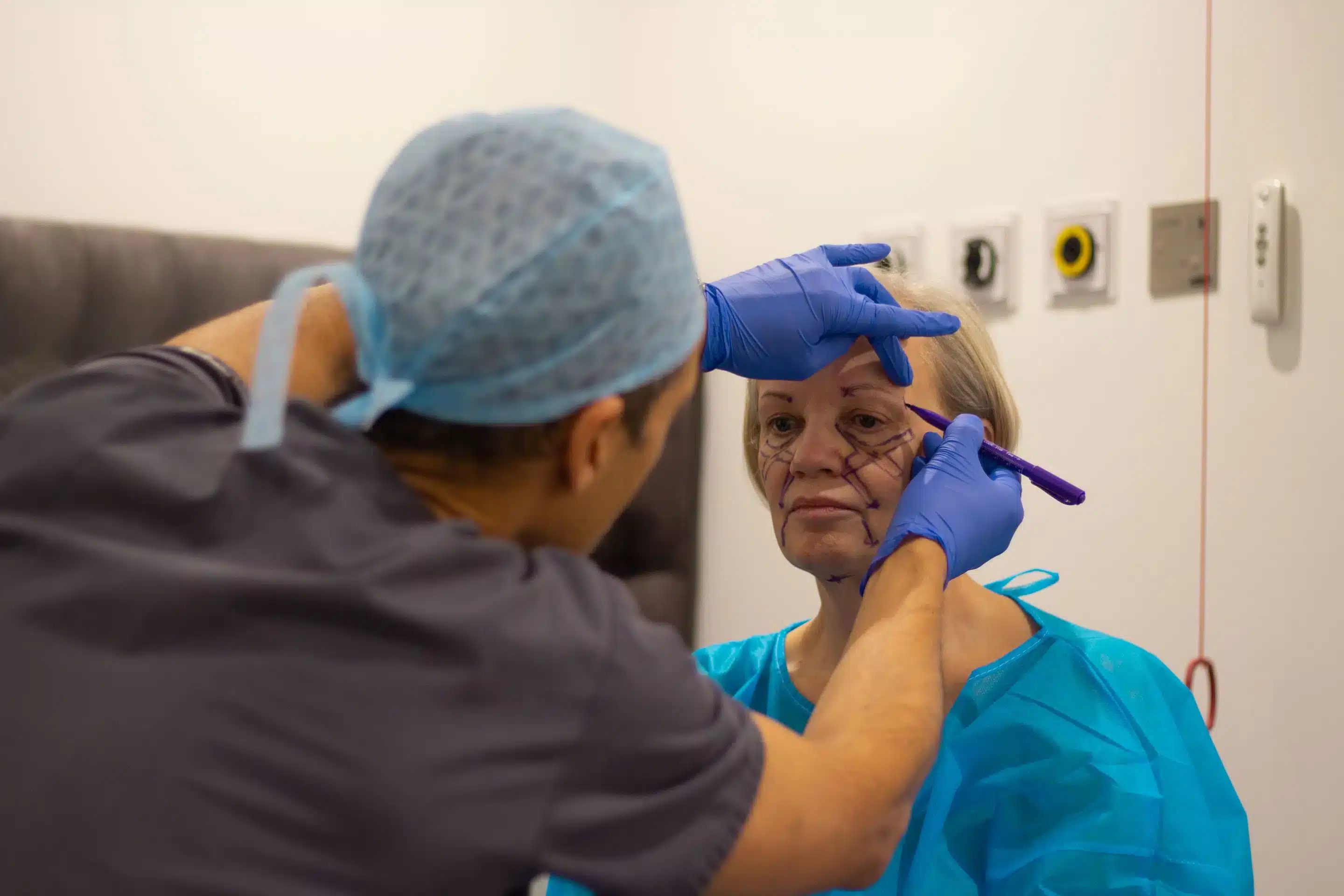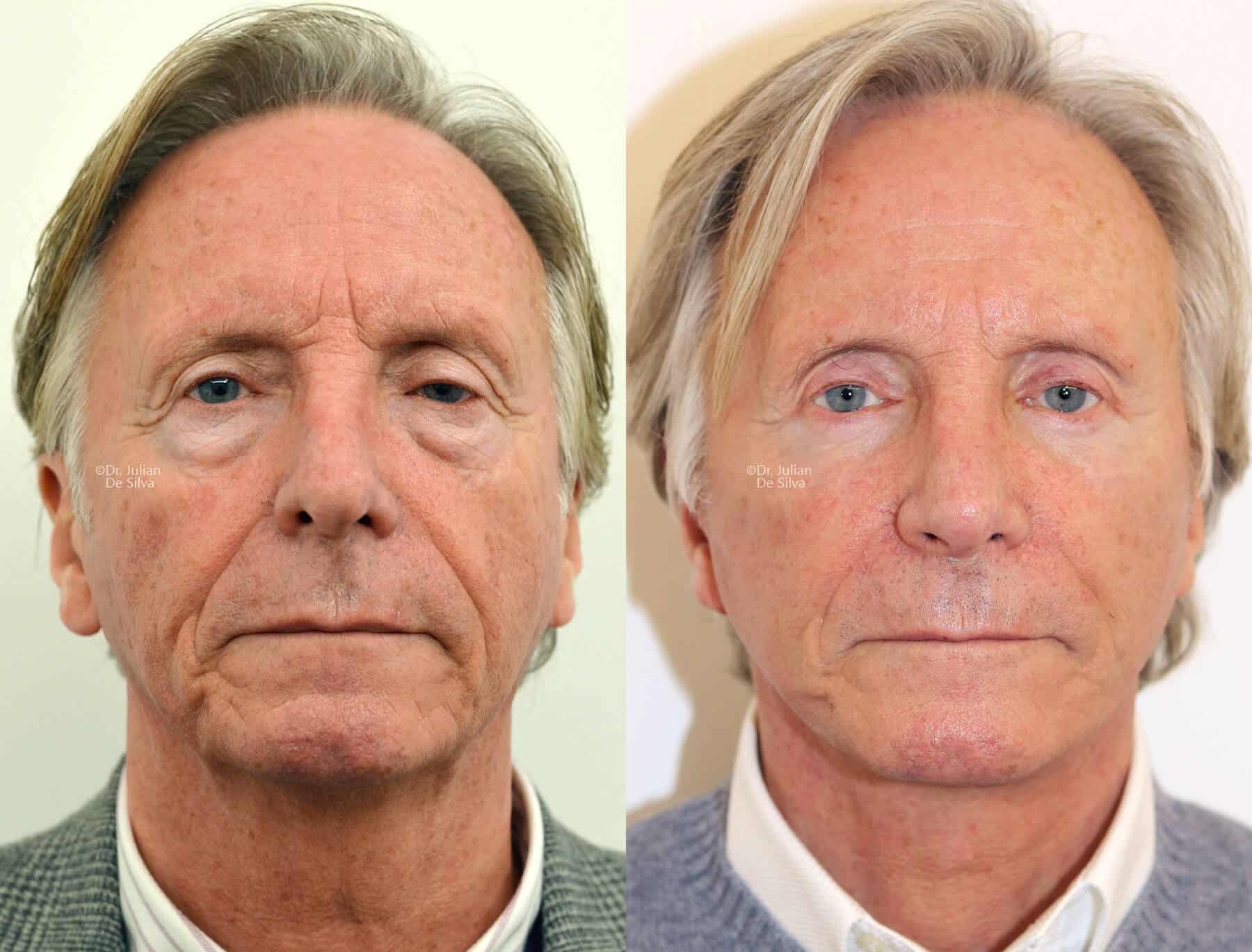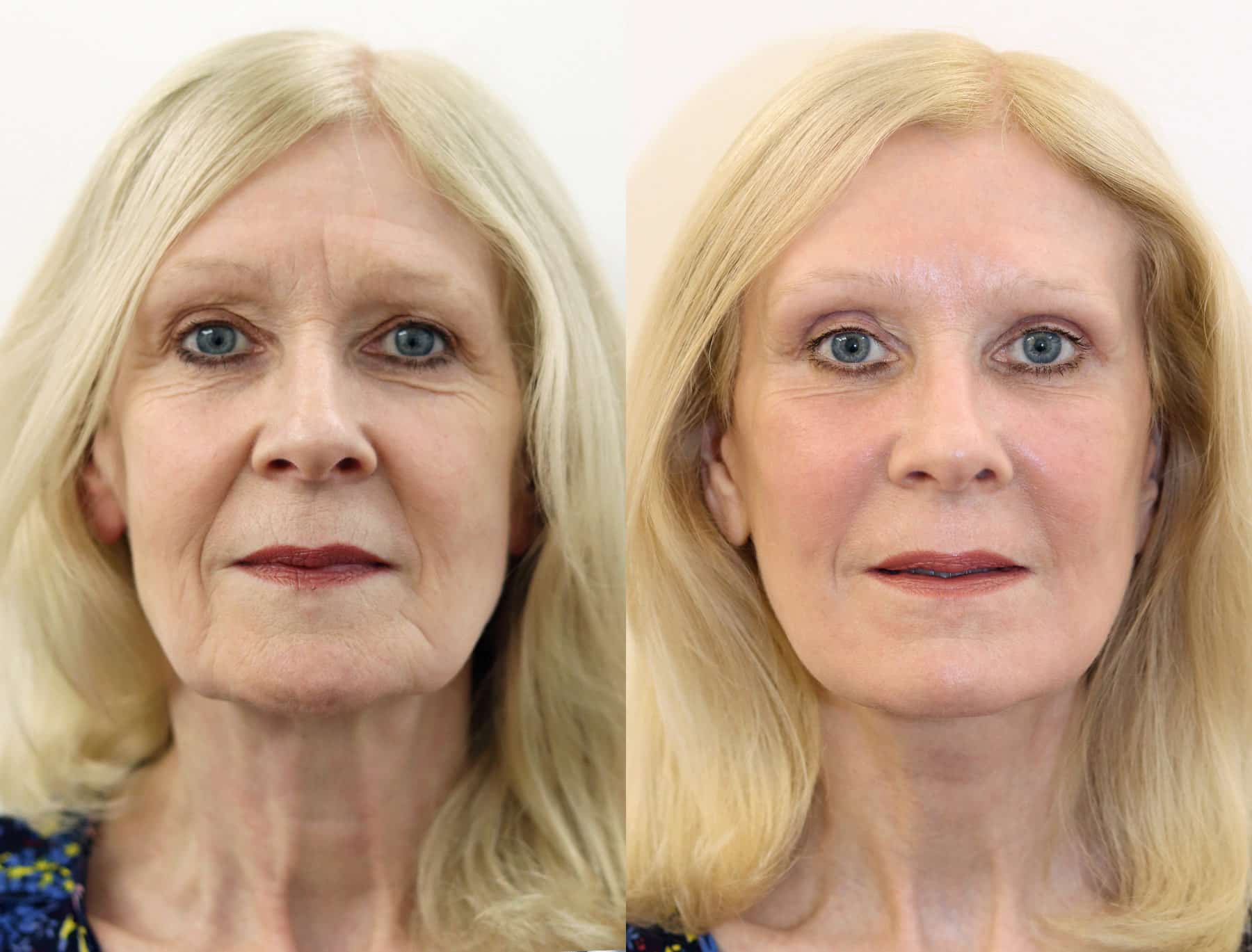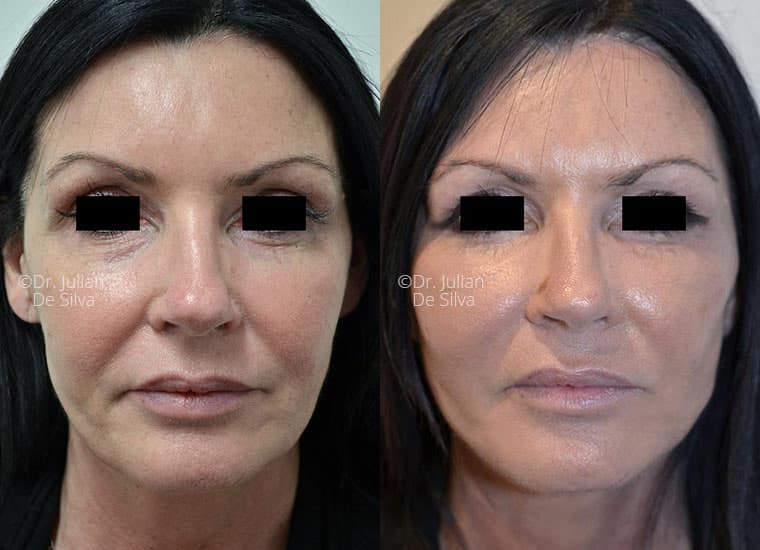
Revision Facelift
- 30% of Dr De Silva’s surgeries are Facelift & Neck Lift Revisions
- Focus on Natural results with signature Vertical Face Restore 7
- Author of The Facelift & Neck LIft Book
What Is A Revision Facelift?
A revision facelift is a specialised procedure designed to address unsatisfactory results or complications from a previous facelift. It aims to refine and improve the outcome, restoring a natural, youthful appearance while addressing concerns such as asymmetry, scarring, or persistent sagging.
Performed by experts including Dr De Silva, revision facelifts require advanced techniques and precision to enhance facial harmony and achieve natural-looking results. There is some degree of scarring and change in the natural anatomy. Whether the initial surgery fell short of expectations or ageing has further impacted the skin, when performed by a qualified surgeon, a revision facelift in London provides a chance for rejuvenation. This specialised procedure, performed by board-certified facial plastic surgeon Dr De Silva, can restore confidence and refine your Natural appearance. Dr De Silva finds Key for a natural appearance is looking at old photographs to see how your individual face has changed and use that as a template for revision facelift and neck lift surgery.


Why Our Harley Street Patients Seek Facelift Revision Surgery
Loose skin, fullness in the neck, deep facial lines, a tired appearance and unsatisfactory scarring are some of the common reasons patients seek revision facelift surgery. While most of these concerns are minor and can be corrected, they may occur even in skilled hands due to individual healing processes, which play a crucial role in facial surgery outcomes. Dr De Silva addresses these issues with his specialised revision facelift surgery in World Renowned Harley Street, London. Many patients travel internationally and nationally for revision procedures.
Correcting Tightness and Structural Imbalance
Deformity from skin tension after facelift surgery occurs when excessive pulling distorts natural contours, leading to an unnatural, tight appearance. Other signs include earlobe distortion and lack of tragal definition. Revision surgery restores balance, ensuring a smoother, more natural result.
Correcting Shape and Symmetry Issues
When the lift direction is backwards instead of upwards, the face can appear windswept and overly tight in the mid-face. Unreleased deeper ligaments may cause a bulging lateral sweep deformity, which becomes more pronounced during animation or smiling.
Poor Incision Placement
Poorly placed facelift incisions can negatively affect the hairline around the ear. A scar extending vertically into the hairline in front of the ear can restrict vertical lift and risk loss of the temporal tuft (sideburn).
Scarring
Poorly placed or noticeable scars can detract from the natural results of a facelift, drawing unwanted attention and causing dissatisfaction. Issues such as thickened scars, visible incisions in the hairline, or irregularities like triangular notches can disrupt facial harmony. As part of a revision facelift, Dr De Silva aims to reduce existing scarring and achieve a more natural result. Expectations are key as scarring can be improved, but not completely removed, as genetics also plays a role in the healing of scars.
Interested In a London Revision Facelift? Discover Our Real Patient Results
Dr De Silva avoids a “one-size-fits-all” approach, focusing instead on subtle enhancements that bring out your best features while addressing areas of concern. Discover our real-life patient transformations.




Why Choose Dr. De Silva As Your Revision Facelift Specialist?
Many patients feel apprehensive about revision surgery, often due to unsatisfactory results from a previous procedure and concerns about undergoing further treatment. Dr Julian De Silva, a highly regarded facial cosmetic and plastic surgeon, specialises in revision surgery and is dedicated to achieving natural-looking outcomes that restore your confidence and satisfaction.
With over 20 years of experience and expert training in London, New York, and Los Angeles, Dr De Silva combines pioneering techniques with an artistic approach to deliver balanced and harmonious results. As a Director of the ASOPRS Facelift and Neck Lift Course and operating from a CQC-accredited Harley Street clinic, he is committed to excellence in patient care.
Dr De Silva takes the time to discuss every aspect of the revision process, offering thorough explanations, recovery guidance, and emotional support before and after surgery. By personalising each treatment to the unique needs of his patients, he fosters long-term relationships, ensuring ongoing care for years to come.
- Known for ‘Natural’ signature facial surgery
- Specialises Face Only surgery, does not operate on the body
- Author of 3 Books on Facial Surgery
- Board Certified by the American College of Surgeons and British Royal College Societies
- Facelift Educator at the American Academy International Meeting
- Over 1000 5-star reviews from patients
Read What Our Satisfied Patients Say About Us
Excellent results from Dr. de Silva and the entire team. The level of care, the treatment itself, support during recovery and post-op review were top notch.
- George Flourentzos
Discover More About Your London Revision Facelift Surgery
Dr. De Silva is highly skilled in achieving excellent results with revision surgery and carefully selects cases where he is confident of meeting the patient’s expectations. If he believes the desired outcome cannot be realistically achieved, he may advise against proceeding with further surgery.
Facelift Revision Consultation
Dr De Silva regularly asks patients to send information such as medical history and photographs of their faces in advance of consultation so that he may review and consider whether he can help. Although many patients’ symptoms can be improved substantially, it is important to have a discussion regarding setting realistic expectations for revision surgery, as the previous scarring cannot be reversed, only improved. A small proportion of patients may require two procedures to achieve their desired results. Your needs, aesthetic goals and medical history will be discussed in a private consultation and a personalised treatment plan will be devised by Dr De Silva for you to follow. Dr De Silva likes patients to bring old photographs as these can be used as a template for improvement.
Preparing For Your Revision Surgery
Preparing for revision facelift surgery involves several important steps to ensure the best possible outcome and a smooth recovery. Dr. De Silva may recommend medical tests in advance and advise you to adjust certain medications or quit smoking at least two weeks before your surgery date to optimise healing. It's equally important to plan your downtime, including arranging transportation for your return home and organising for someone to assist you during the first 24 hours after surgery, allowing you to focus on resting and healing comfortably.
Your Facelift Revision in London
Dr Julian De Silva’s Revision Facelift Surgery aims to address complications from previous procedures, such as visible scarring, unnatural tension, and asymmetry, with precision and advanced surgical techniques. Key factors in achieving improved outcomes include meticulous incision placement within natural creases, bevelled incisions in hair-bearing areas to conceal scars, and a multi-layered closure using fine sutures instead of staples to optimise healing and minimise scarring.
Dr De Silva specialises in the deep plane facelift technique, which lifts deeper facial tissues to relieve skin tension and create natural, long-lasting results. He also incorporates cutting-edge regenerative medicine to enhance scar resolution and improve tissue recovery. Revision surgery is a more complex procedure due to the presence of existing surgical scarring and changes in the natural anatomy which often require additional specialist techniques to improve the aesthetic results. For many patients, Dr De Silva uses combination techniques including fat transfer, chin augmentation and skin resurfacing, to enhance the results.
To further optimise patient safety and recovery, Dr De Silva performs revision facelifts under sedation anaesthesia rather than general anaesthesia, reducing risks and enabling a quicker, smoother recovery process.
Follow-up Appointments
Shortly after your initial surgery, Dr De Silva will review your healing process and remove any sutures during your follow-up consultation. Your healing process will be closely monitored to ensure optimum results.
When Can You Return To Daily Activities?
Dr De Silva’s patients normally return to their daily routines 2 to 3 weeks after surgery, depending on individual healing and the complexity of the procedure. Swelling and bruising are significantly reduced during this time and thanks to the careful placement of the incisions, scars are barely visible.
What to Expect from Recovery
As a consequence of having a previous facial surgery, the recovery for patients after revision surgery can be longer as swelling can take time to resolve. For some patients, the use of regenerative medicine after surgery can be a powerful tool to speed up recovery after surgery. Final results are generally visible 12-18 months after surgery.
Is Facelift Revision Surgery Right for You?
If you think that you are an ideal candidate, Dr De Silva recommends booking a consultation to discuss your concerns. Candidates should be in good overall health, have realistic expectations, and seek improvement in areas such as facial balance, contour, or scar appearance.
Even the Best Revision Facelift Surgery Comes With Risks
While all surgical procedures come with their share of risks, these are greatly reduced thanks to Dr De Silva’s extensive expertise and training in facelift surgery. Some of the possible risks of revision facelift surgery can include bleeding, infection, poor wound healing, persistent pain, temporary or permanent hair loss, facial nerve injury, and skin irregularities. Yet, these are a rare occurrence amongst Dr De Silva’s patients in his London practice.
Watch: A London Revision Facelift Patient Shares Her Journey
Further Enhance Your Facial Profile
Some patients choose to use their surgery time to incorporate additional procedures to further rejuvenate their face and turn back the effects of ageing.
Chin Augmentation
Chin augmentation enhances facial harmony by improving chin projection and definition. It complements a revision facelift by balancing facial proportions and creating a more refined, youthful profile.
Fat Grafting
Fat grafting restores lost volume by transferring purified fat to areas such as the cheeks or under-eyes. Combined with a revision facelift, it enhances facial fullness and rejuvenation naturally.
Neck Lift
A neck lift refines the jawline and eliminates sagging skin or banding in the neck. When paired with a revision facelift, it creates a cohesive, youthful, and balanced appearance. Many patients required a combined revision facelift and neck lift to get the best natural result.
Skin Resurfacing
Many patients have some degree of skin ageing including fine lines, enlarged pores and sun damage. Dr De Silva often favours using a triad treatment to improve skin quality and rejuvenation (CO2 laser resurfacing, Radiofrequency and regenerative medicine). Laser resurfacing stimulates collagen in the very superficial skin, radio frequency tightens the skin 2 to 4 mm below, and return to medicine heals your body faster by using your own growth factors to improve healing and recovery time.
Book A Consultation With A Revision Facelift Specialist
Dr De Silva understands the anxiety and frustration that can accompany the prospect of another facelift surgery. With his compassionate approach and unrivalled expertise, he is dedicated to guiding you through the process with clarity and care.
Book a consultation today to discuss your concerns, explore custom solutions, and take the first step towards achieving the natural, harmonious results you deserve.
Frequently Asked Questions
Dr. De Silva treats a large number of revision patients from overseas, and our specialist team is here to support you every step of the way. We can assist you with organising virtual consultations and your trip to the UK. To further enhance your recovery, we offer access to the latest technologies, including oxygen therapy and regenerative medicine. For your convenience and peace of mind, we can also arrange for you to stay in a serviced apartment located above our Harley Street clinic, ensuring you are close to medical staff throughout your recovery.
